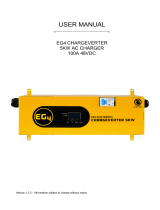
Contents
Contents ........................................................................................................................................................................... 1
1 Abbreviations ........................................................................................................................................................... 3
2 Safety ........................................................................................................................................................................ 4
2.1
Safety Instruction ............................................................................................................................................. 4
2.2
Important Safety Notifications ......................................................................................................................... 4
3 Brief Introduction ..................................................................................................................................................... 5
3.1
Product Description .......................................................................................................................................... 5
4 Battery Overview ...................................................................................................................................................... 6
4.1
System Connections ......................................................................................................................................... 6
4.2
Overview of System Components ..................................................................................................................... 6
4.2.1 Battery Diagram ....................................................................................................................................... 7
4.2.2 Emergency Stop (RSD, ESS Disconnect) ................................................................................................... 8
5 Installation ................................................................................................................................................................ 9
5.1
Packaging List and Placement ........................................................................................................................... 9
5.2
Location Selection and Installation ................................................................................................................... 9
5.2.1 Storage ..................................................................................................................................................... 9
5.2.2 Requirements for Installation ................................................................................................................. 10
5.2.3 General Installation ................................................................................................................................ 11
5.2.4 Installation in EG4® Battery Rack............................................................................................................ 12
5.3
Battery Communications ................................................................................................................................ 13
5.3.1 Connecting multiple batteries in parallel ............................................................................................... 13
5.3.2 Communication Cable Pinout and DIP Switch ID Tables ......................................................................... 13
5.4
Installing with Different EG4 ® Battery Models .............................................................................................. 15
6 Battery Operation ................................................................................................................................................... 16
6.1
LCD Screen ...................................................................................................................................................... 16
6.1.1 Button description .................................................................................................................................. 16
6.1.2 Waking up the LCD screen ...................................................................................................................... 16
6.1.3 Cell Information ...................................................................................................................................... 17
6.1.4 Temperature Information ....................................................................................................................... 17
6.2
Communication Protocol Selection ................................................................................................................ 17
6.2.1 Protocol Change/Selection Procedure ................................................................................................... 17
6.3
BMS Tools Installation and Interfacing ........................................................................................................... 18




















